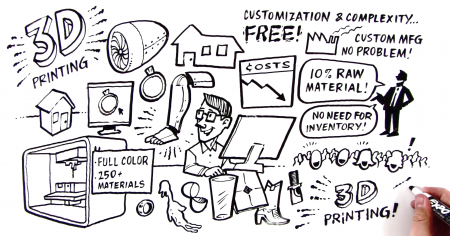March 31, 2019 – It has been a while since I shared with you a missive from Peter Diamandis, the futurist, and entrepreneur who is best known for Singularity University, and the XPrize. In this posting which I have adapted for 21st Century Tech Blog, Diamandis describes the current and future state of this technological advancement.
What is 3D printing, also described as additive or augmented manufacturing? It is a process where digital-rendered drawings and schematics get translated into a finished object using a printer capable of producing complex structures. The printheads on these printers use inks that can be metals, plastics, ceramics, glass, rubber, leather, stem cells, and almost anything else you can turn into “ink.”
The current lot of 3D printers are capable of producing full-colour objects made from more than 250 different inks. The technology prints layer-by-layer until an object is completed. It has not been a fast process but that is changing. More recently, groundbreaking stereolithography has succeeded in producing complex shapes at much faster speeds, up to 100 times quicker than previously seen. These printers use a bed of photoreactive liquid resin and apply different light wavelengths to selectively harden the resin as it is released and thereby achieve continuous printing rather than the incremental layering of old. The technology is material efficient eliminating the waste common to earlier versions of the technology or more traditional manufacturing processes. In fact, with these new 3D printers, raw material reductions reach as high as 90%.
Avi Reichental’s Top 3D Printing Predictions
Diamandis’ friend Avi Reichental is his “go-to expert” in augmented manufacturing and the Founder and CEO of XponentialWorks, an advisory, venture investment, and incubation ecosystem company that aims to monetize exponential technology innovation and business model disruption.
For 12 years, Reichental served as the CEO of 3D Systems, the largest publicly traded 3D printing company in the world. An early additive manufacturing pioneer, he was also part of the core faculty at Singularity University.
By 2024, Reichental predicts:
- 50% of all manufacturing companies will have 3D printing operations in production;
- 40% of all surgeons will practice with 3D models;
- 50% of all consumer businesses will have revenue-earning 3D printing operations.
But it doesn’t stop there. Already, major international breakthroughs in additive manufacturing are accelerating these trends and giving birth to new convergent applications.
The Next 5 Printing Breakthroughs (2019-2024)
- 3D printing speeds are slated to increase by 50X – 100X. – 3D printing rates typically have been limited by
- how much force a printhead can apply
- how fast a printer can heat the material to induce flow and
- how quickly the printhead itself can move.
In a new feat, however, the MIT Laboratory for Manufacturing and Productivity recently created a printer 10 times faster than traditional desktop models and three times faster than a $100,000 industrial-scale system. Achieving record speeds, the MIT team printed a helical bevel gear in a mere 10 minutes, and a pair of eyeglass frames in only 3.6. The acceleration of 3D printing will revolutionize nearly every industry, from retail to manufacturing.
- Sustainable, affordable, 3D-printed neighborhoods are launched. – Construction and real estate industries will experience disruption at monumental scales as 3D-printed homes offer cheaper, environmentally-friendly alternatives to traditional housing. The first 3D-printed homes appeared last year in the Dutch city of Eindhoven, where a shortage of bricklayers increased demand for this technology. These futuristic buildings waste less cement and cut costs and resources. In future, home printers will incorporate the infrastructure associated with the build including drainage pipes, wiring, and even smart sensors, rendering a fully integrated living experience. And more recently, a startup called NewStory has been able to build 100 homes in 8 months for about $6,000 USD each.
- Convincing and delicious 3D-printed steaks and burgers in fine restaurants on Earth and in space. – 3D-printed “meat” using plant-based proteins to provide a more sustainable solution to feed the world’s growing population. Livestock produces 14.5 to 18% of global human-induced greenhouse gas emissions. Yet 3D-printed meat will provide the same satisfaction as meat consumption without the harmful environmental impacts. Over the next five years, production costs will fall and quality will improve. Israeli company Chef-it and Giuseppe Scionti’s NovaMeat are making significant progress.
- Metal 3D printers will overtake plastics. – Prepare for the emergence of 3D-printed jewelry, car and airplane parts, kitchenware, and all kinds of prototypes. 3D metal printers will not only eliminate waste in manufacturing, but will also be able to create more lightweight parts, a development especially pertinent to aircraft construction. The technology will allow consumers the flexibility to do home design. And biodegradable cellulose may replace plastic as a commonly used ink medium as the MIT Laboratory for Manufacturing and Productivity has demonstrated with its 3D-printed antimicrobial surgical forceps. This mechanically robust, chemically versatile material is one example of the endless possibilities of how 3D-printed materials will bo well beyond just plastic.
- “Heh” will be the most frequently used command in design engineering. – “Heh Cogni, design me a new pair of shoes, 8.5 Medium, with load bearing for my weight,” is a phrase Reichental anticipates will be used by us over the next five years. Smart 3D printers with natural language processing, AI-powered generative design, and customization capabilities will allow for seamless engineering design. “Think of the complete fashion industry that doesn’t have cutting and sizing and waste and that can create bespoke garments, shoes, belts, accessories, food,” Reichental notes. “There is not going to be a single industry that will be spared by the next wave of additive and generative design.”
















